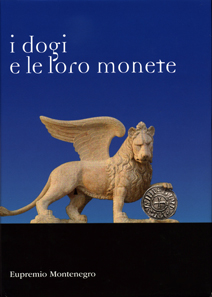April 11, 2013 – For more than 1,000 years the Lagoon City of Venice has struck coins. The Serenissima’s coins for long distance trade dominated mediaeval coinage and led to numerous imitations. Now, Eupremio Montenegro has published an enormous catalogue comprising all Venetian issues with their respective market value.
Eugenio Montenegro, I dogi e le loro monete. Eupremio Montenegro Editore, Turin, 2012. 999 p. with colour images. Hardcover, 24,7 x 17,4 cm. ISBN 88-88894-03-9. Price: 120,00 euros.
Not many cities have issued coins so regularly, in such quantities and since so long as Venice. This makes the edition of a corpus of the Venetian coinage truly a Herculean task. Eupremio Montenegro had published so many corpora before and has now accepted, in addition, this challenge. The result is an impressive book that will doubtlessly open this interesting field of numismatics to many new collectors.
The period dealt with in this catalogue spans more than 1,000 years. It starts with Louis the Pious and ends with the Venetian issues of the Austrian Emperor Francis Joseph who ruled over the Lagoon City until 1866. The major portion of the coinage was issued, naturally, under the dogi who gave the catalogue its name.
Each single doge is presented with an overview of his life, career, and his achievement in history. Then follow his coins categorised into gold and silver giving always the approximate fineness. The silver coins, in particular, reveal very quickly how low the small change’s fineness actually was. After the coins the oselle are presented. For every type are given the complete legend of obverse and reverse, a detailed description, as well as its size and average weight. There are no bibliographical references, though. However, the collector is offered the rarity and prices according to four different gradings: Fine – Very Fine – Extremly Fine – FDC. Now and then the collector will find some hints at the rarity and numismatic relevance of the pieces. The catalogue is lavishly illustrated, although, naturally, it was impossible to illustrate all 3,458 records with a photo.
Besides the proper Venetian issues, additionally there is much more, although, we have to say, with a numbering system which confuses from time to time: a catalogue of the imitative coins and siege coins, of the doges’ official seals, of the Terra Ferma coins, the issues of the Venetian colonies and of countermarks; in short: this book covers everything you might connect with Venice from a numismatic point of view.
First the reader is offered a short overview of the city’s history, of the mint, and of the most important denominations. A brief chapter is dedicated to the greatest counterfeiter of Venetian issues, Luigi Cigoi. It is here, in particular, where one might miss sorely images.
And while we are on the subject of missing something. There is one wish regarding a future edition: an index of the obverse legends in order to find much more easily a specific coin in these more than 900 pages.
This catalogue of Eupremio Montenegro is, anyway, a very useful book. The topics are neatly arranged and any collector or dealer may use it even if they do not speak Italian. ‘I dogi e le loro monete’ will certainly become a new reference guide. Therefore we wish this book many, many new editions.
You may order the book directly through Eugenio Montenegro’s website.





